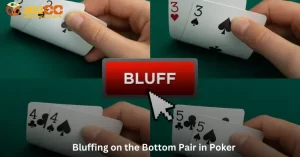While the bottom and top pairs sound similar, few poker players master how to work the Bottom Pair into a hand gracefully. Understanding and playing the Bottom Pair may be less appealing compared to whenever you hit either an even stronger hand or a top pair.
However, it considerably enhances your general game for higher wins especially in Jilicc players. In this article, Jilicc will discuss what the Bottom Pair in Poker entails and how it affects or impacts your strategy and will provide you with a few key tips to make the most out of it.
What’s a Bottom Pair in Poker?
The bottom Pair in Poker is the weakest possible pair you can work out with your hole cards paired with community cards on the flop. More precisely, it happens when one of your hole cards pairs the lowest-ranking card on the flop.
For example, in Texas Hold’em, with a flop of K-9-3 and a 3 being one of your hole cards, you have a bottom pair. It’s a better rank than no pair at all. However, the bottom pair often gets highly vulnerable, especially when paired with higher pairs in cases when opponents may be holding the higher kicker.
Why Bottom Pair Matters in Poker

Although it may be weak, the Bottom Pair is worth something and can be potent. Too many amateur players fold off with bottom pairs way too early or misplay their bottom pairs simply because they don’t know how to properly use them. Once you learn how to play this hand type, you’ll avoid losing more hands than you need to when opponents get overly cautious.
Now, let’s deconstruct the situations where the Bottom Pair becomes applicable to your general poker strategy.
When to Play Bottom Pair in Poker
Playing the bottom pair the key to playing it right is to know both when to play it and when to fold. Here are a few situations in which it might be profitable to play a bottom pair:
1. Small Pots and Weak Opponents
The bottom pair is more valuable in the small pots, especially if playing against weak or extremely cautious opponents. Many players fold completely on the flop, and a bottom pair may be enough to take the pot with a smallish continuation bet.
=> Strategy Tip: A very small bet can give your opponents a reason to fold if they don’t have much strength. Pay attention to their player type; if they tend to fold to pressure, the bottom pair may be good enough to win the pot.
2. Position Matters
So, playing in a late position with a bottom pair can be to your advantage. Providing your opponents have checked with you, there is a pretty good likelihood they’re not holding strong hands, and you can move into taking the pot.
=> Strategy Tip: Use your position in order to make a judgment based on the board and the action or possible action of your opponents. A bottom pair bet might well take the pot if nobody has shown any substantial strength so far, especially on a fairly dry board that doesn’t include many high cards.
3. Heads-Up Situations
In general, bottom pairs in poker are very good in heads-up situations to take the pot down with, for the simple fact that you have fewer opponents to beat, thus raising the chances of your bottom pair holding up.
=> Strategy Tip: You should be more confident playing your bottom pair, heads-up, especially if that opponent hasn’t been overly aggressive. With a well-timed bet or check, they might fold.
=> Are you looking for a reputable and top quality casino? Try our partners: Phwin.
When to Fold Bottom Pair
Of course, Bottom Pair isn’t a hand you should always play. Rather, there are several situations where folding is smartest:
1. Aggressive opponents
If you are facing overly aggressive opponents who raise or bet fairly frequently, it is generally advisable to fold the bottom pair in favor of calling an oversized bet. The threat of having some other pair higher or a better hand simply becomes too great.
=> Strategy Tip: Never get too attached to your bottom pair. In case your opponent shows great aggression, this is usually a fold – especially in multi way pots – to wait for a better hand.
2. Hazardous Board Textures
The more high cards are out on the board or possible straight and flush draws the more precarious is the bottom pair. The likelihood that your bottom pair is behind goes up when you see boards reading something like Q-J-10 or K-9-8.
=> Strategy Tip: Don’t get stuck in these. If the board is coordinated and full of high cards, fold to others as your bottom pair is unlikely to hold up.
3. Multi-Way Pots
But in multi-way pots, the chance that somebody has an even better hand increases significantly. Even when you think your bottom pair might be the best hand on the flop, the fact there are several opponents means it’s more likely that one of them will improve on later streets.
=> Strategy Tip: Be cautious in multi-way pots. You’re almost always best folding a bottom pair unless you’re sure your opponents are weak or passive.
Bluffing on the Bottom Pair in Poker

One of the more interesting tactics you can employ is to make use of your bottom pair as part of a bluff. Since bottom pairs hold very little value in most situations, they really can serve as ideal hands to bluff in situations that present themselves.
1. Semi-Bluffing
Semi-bluffing with a bottom pair means betting or raising so that you will fold if resistance comes up, yet you still retain good enough equity in hand. Example: You have a bottom pair, and either a possible flush or straight draw, and you can bluff on the flop or turn while still retaining outs to the improvement if called.
=> Strategy Tip: You want to time your semi-bluff with the bottom pair when you have some backdoor draws. Should your opponent decide to call, you still have a shot at hitting a better hand on future streets.
2. Representing Stronger Hand
If the board looks scary for example, an ace or king comes on the flop you sometimes can rep a stronger hand and fold your opponents. Bluffing a bottom pair in these spots is very risky but rewarding if pulled off correctly.
=> Strategy Tip: Only try this against tight opponents who respect aggression. Certainly don’t overdo this because it could backfire; it’s very important to be selective about when you bluff off with the Bottom Pair in Poker.
Final Thoughts
The Bottom Pair in Poker isn’t very glamorous but is definitely crucial in poker strategy. Given the right knowledge on when to play, when to fold, and how to bluff with it, there’s unwavering assurance of maximizing profit and minimizing any loss. To Jilicc players, this could definitely come in very useful for subtleties that separate walking away with a profit or falling short.
=> Read more: What patterns in Poker at Jilicc should you know?
By following the outlined tips in Jilicc’s guide, you will be better armed to handle those tricky situations once you hit a Bottom Pair. If you keep practicing these techniques and remain patient enough, then it won’t be long before even the weakest pairs result in really big wins.


